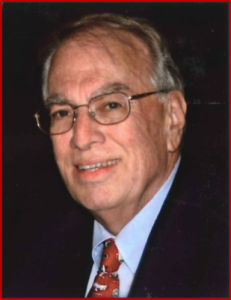
“Flint has an incredible history and I wanted folks to be proud of that heritage. I hope these files will be useful to new generations.”
The Sloan Museum is the beneficiary of donation from Lawrence R. Gustin, aka Larry in auto circles, a distinguished automotive and Flint historian that includes the personal papers of William C. Durant, the General Motors founder.
Gustin, a Flint native, was a writer and editor at the Flint Journal from 1960 to 1984 and later assistant public relations director of Buick before retiring in 2005. He was and is an active supporter of press organizations, including the Automotive Press Association.
Gustin wrote three critically acclaimed books: “Billy Durant: Creator of General Motors” (1973, updated 1984 and 2008), the first biography of the GM founder; “The Buick: A Complete History” with his late co-author Terry B. Dunham (1980, updated in five more editions through Buick’s centennial in 2003) and “David Buick’s Marvelous Motor Car” (2006, revised with Kevin M. Kirbitz in 2011 and 2013), the first biography of the founder of the Buick automobile.
Gustin also created “The Flint Journal Centennial Picture History of Flint” in three editions in 1976-77. The Durant and David Buick books were recently translated into Chinese and published in Shanghai.
The donation, the Lawrence R. Gustin Archives, holds copies of Durant’s autobiographical notes with his handwritten comments in the margins. They describe his start in carriages, how he founded GM after taking over Buick, and how he later created the Chevrolet car with the help of Buick racing star Louis Chevrolet, that he used to regain control of GM from bankers. Chevrolet, of course, later became part of GM.
Durant’s relationships with Charles W. Nash and Walter P. Chrysler are detailed after working for Durant in Flint. Letters show how Durant persuaded Charles Stewart Mott to relocate his axle company in 1906 from Utica, NY to Flint to supply Buick – the beginning of Mott’s huge fortune that resulted in the Mott Foundation. Durant describes how he created AC Spark Plug with Albert Champion. Gustin interviewed Mott several times, including for Mott’s 95th birthday, and had long conversations with Durant’s widow, Catherine, in New York and New Jersey shortly before her death. Some of those talks are preserved on audio tapes in the archives.
The archives also have personal letters between Durant and his wife, other auto execs, and messages from his grandfather, Michigan Gov. Henry Crapo, in the 1860s. Crapo, a Flint lumber baron and governor during the Civil War, wrote to his grandson when “Willie” was a young child living with his parents in Boston.
The collection also relates how Durant backed a small refrigerator company and came up with its name – Frigidaire – and how he also created the Chevrolet “bow tie” logo. There’s an exchange of letters between Durant and Winston Churchill at the end of World War I. Documents give personal insights into Durant’s controversial ouster from GM in 1920, his later creation of Durant Motors, his bankruptcy in 1936 and his last years running a Flint bowling alley.
The archives – of course – include information on David Buick, whose career was largely unknown and his name almost forgotten, except as a car brand, until “David Buick’s Marvelous Motor Car” was published. There are also many videos, some used in “Legend of Buick,” a work-in-progress DVD of rare film and/or audio of auto pioneers. It includes more recent auto leaders such as Flint’s Harlow Curtice, who headed Buick from the early 1930s through the World War II years and then became a GM chief executive. Curtice was Time magazine’s 1955 “Man of the Year.”
“I never learned very much about Flint history growing up. So when I found out what amazing industrial developments took place here, and how many important auto pioneers worked here, I spent a lot of time trying to tell those stories,” Gustin old AutoInformed.
When the city was considering razing the old Durant-Dort Carriage Co. office building in the mid-1970s, Gustin launched a successful newspaper campaign to save it as what was arguably the birthplace of GM. That led to it becoming Flint’s only National Historic Landmark. He helped create the Buick Gallery and Research Center at Sloan Museum and wrote the inscriptions for Joe Rundell’s statues of local auto pioneers in the last several years. He plans to donate to the archives his collection of 35 DVDs of Central-Northern Thanksgiving football games (1930s-’70s), which in several decades drew crowds of 18,000-20,000 at Atwood Stadium.
Gustin received a Distinguished Service Citation from the Automotive Hall of Fame in 1999 for his historical work and was elected to the Hall of Fame of Michigan State University’s campus daily, the State News, in 2007. He is a 1959 graduate of MSU. He and his wife Rose Mary now live in Oakland County, have two sons and five grandchildren. His parents were the late Robert S. and Doris M. Gustin of Flint.
The collection will be accessible to researchers once inventoried and catalogued into the museum collection. Appointments to view the material, once ready, can be made by contacting Jeremy Dimick, curator of collections at (810) 237-3440 or collections@sloanlongway.org.


Pingback: Embracing the Inevitable? – Buick all EVs by 2030 | AutoInformed